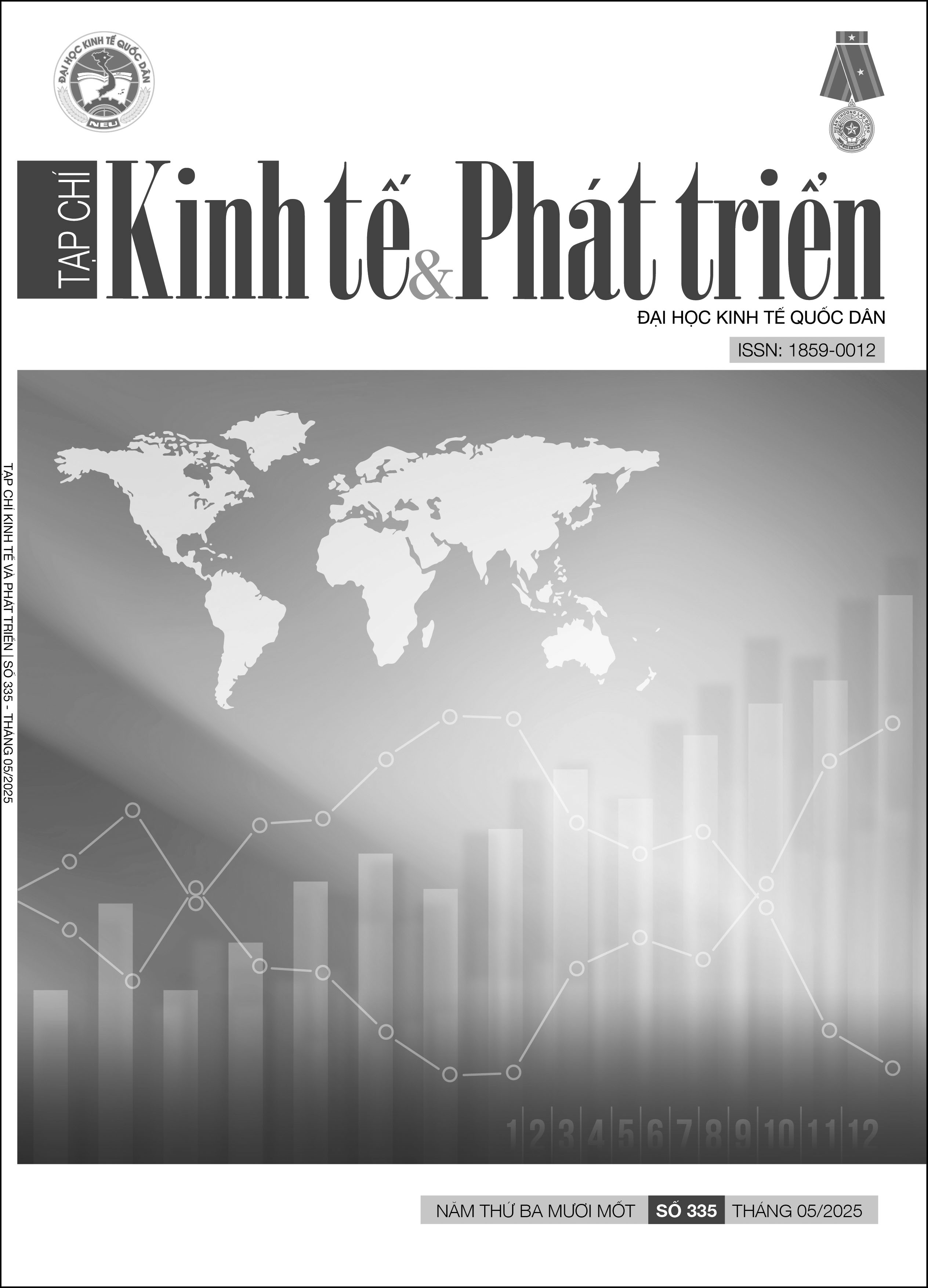Áp lực của các bên liên quan và đổi mới sáng tạo sinh thái của doanh nghiệp dệt may Việt Nam: vai trò của danh tiếng doanh nghiệp và áp lực từ thị trường quốc tế
DOI:
https://doi.org/10.33301/JED.VI.2219Từ khóa:
: Đổi mới sáng tạo sinh thái, danh tiếng doanh nghiệp, dệt mayTóm tắt
thông qua danh tiếng của doanh nghiệp trong ngành dệt may Việt Nam. Dựa trên lý thuyết thể chế, lý thuyết các bên liên quan và quan điểm dựa trên nguồn lực, nghiên cứu xem xét vai trò trung gian của danh tiếng doanh nghiệp và tác động điều tiết của áp lực thị trường quốc tế. Dữ liệu được thu thập thông qua khảo sát 302 doanh nghiệp dệt may xuất khẩu tại Việt Nam. Kết quả cho thấy áp lực của các bên liên quan ảnh hưởng tích cực đến danh tiếng doanh nghiệp, từ đó thúc đẩy đổi mới sáng tạo sinh thái; đồng thời, áp lực thị trường quốc tế cũng củng cố mối quan hệ tích cực giữa danh tiếng doanh nghiệp và đổi mới sáng tạo sinh thái. Nghiên cứu đưa ra những khuyến nghị thực tế cho các nhà quản lý muốn nâng cao hiệu suất môi trường và cho các nhà hoạch định chính sách nhằm thúc đẩy đổi mới sáng tạo sinh thái trong ngành dệt may.
Tài liệu tham khảo
Bansal, P. & Clelland, I. (2024), 'The Role of Media in Environmental Legitimacy', Journal of Environmental Management, 18 (2), 366-380.
Barney, J. (1991), 'Firm Resources and Sustained Competitive Advantage', Journal of Management, 17 (1), 99-120.
Brown, M. & Deegan, C. (2023), 'Social media environmental activism and corporate reputation: A longitudinal analysis of textile industry responses', Journal of Business Ethics, 174 (2), 341-358.
Chen, Y., Wang, W., Zhang, S. & Lin, J. (2022), 'Green Innovation Performance: The Role of Green Dynamic Capabilities', Business Strategy and the Environment, 31 (2), 445-460.
Chin, W. (1998), 'The partial least squares approach to structural equation modeling', Modern Methods for Business Research, 295 (2), 295-336.
Cohen, J. (1988), Statistical Power Analysis for the Behavioral Sciences, 2nd edn, Lawrence Erlbaum Associates, Hillsdale, NJ.
Delmas, M. & Toffel, M. (2008), 'Organizational responses to environmental demands: Opening the black box', Strategic Management Journal, 29 (10), 1027-1055.
DiMaggio, P. & Powell, W. (1983), 'The Iron Cage Revisited: Institutional Isomorphism and Collective Rationality in Organizational Fields', American Sociological Review, 48 (2), 147-160.
Etter, M., Colleoni, E., Illia, L. & Meggiorin, K. (2019), 'Social Media Environmental Activism and Organizational Response', Business & Society, 58 (8), 1699-1731.
Evangelinos, K. & Nikolaou, I. (2009), 'Environmental Accounting and the Banking Sector: A Framework for Measuring Environmental-Financial Risks', International Journal of Services Sciences, 2 (3/4), 366-380.
Fombrun, C., Gardberg, N. & Barnett, M. (2000), 'Opportunity Platforms and Safety Nets: Corporate Citizenship and Reputational Risk', Business and Society Review, 105 (1), 85-106.
Freeman, R. (1984), Strategic Management: A Stakeholder Approach, Pitman, Boston.
Hair, J., Black, W., Babin, B., Anderson, R. & Tatham, R. (2006), Multivariate Data Analysis, 6th edn, Pearson Prentice Hall, Upper Saddle River, NJ.
Hair, J., Hult, G., Ringle, C. & Sarstedt, M. (2014), A Primer on Partial Least Squares Structural Equation Modeling (PLS-SEM), Sage, Thousand Oaks, CA.
Hair, J., Ringle, C. & Sarstedt, M. (2011), 'PLS-SEM: Indeed a Silver Bullet', Journal of Marketing Theory and Practice, 19 (2), 139-152.
Hair, J., Risher, J., Sarstedt, M. & Ringle, C. (2019), 'When to use and how to report the results of PLS-SEM', European Business Review, 31 (1), 2-24.
Hayes, A. & Rockwood, N. (2017), 'Regression-based statistical mediation and moderation analysis in clinical research: Observations, recommendations, and implementation', Behaviour Research and Therapy, 98, 39-57.
Henseler, J., Ringle, C. & Sarstedt, M. (2015), 'A new criterion for assessing discriminant validity in variance-based structural equation modeling', Journal of the Academy of Marketing Science, 43 (1), 115-135.
Khan, M., Zhang, Y., Kumar, A. & Yang, L. (2020), 'Consumer Green Behaviour: An Approach towards Environmental Sustainability', Sustainable Development, 28 (5), 1168-1180.
Klassen, R. & Whybark, D. (1999), 'The Impact of Environmental Technologies on Manufacturing Performance', Academy of Management Journal, 42 (6), 599-615.
Lyon, T. & Montgomery, A. (2013), 'Tweetjacked: The Impact of Social Media on Corporate Greenwash', Journal of Business Ethics, 118 (4), 747-757.
Martinez-Alier, J., Rodriguez-Labajos, B., Lewis, N. & Jenkins, D. (2020), 'The Role of Community-Led Environmental Initiatives in Southeast Asia', Journal of Cleaner Production, 256, 120367.
Nguyen, T. & Kim, S. (2023), 'Environmental communication strategies on social media platforms: Evidence from emerging market firms', Corporate Social Responsibility and Environmental Management, 30 (3), 789-806.
Park, H. & Kim, J. (2020), 'Transition Towards Green Banking: Role of Financial Regulators and Financial Institutions', Asian Journal of Sustainability and Social Responsibility, 5 (1), 1-25.
Rehman, A., Ullah, I., Aslam, M. & Javed, W. (2021), 'Adoption of Green Banking Practices and Environmental Performance in Pakistan', Environment, Development and Sustainability, 23 (9), 13200-13220.
Walker, K. & Wan, F. (2012), 'The Harm of Symbolic Actions and Green-Washing: Corporate Actions and Communications on Environmental Performance and Their Financial Implications', Journal of Business Ethics, 109 (2), 227-242.
Walker, K. & Wan, F. (2022), 'The role of social media in shaping corporate environmental reputation: A multi-stakeholder perspective', Business Strategy and the Environment, 31 (4), 1232-1249.
Zhang, X., Wang, Y., Chen, J. & Li, W. (2022), 'Do Green Banking Activities Improve Banks' Environmental Performance? The Mediating Effect of Green Financing', Sustainability, 14 (2), 1-18.





